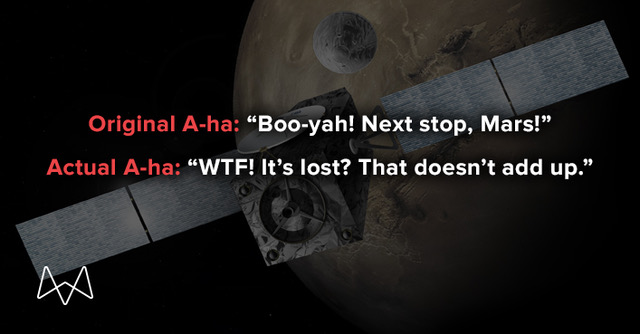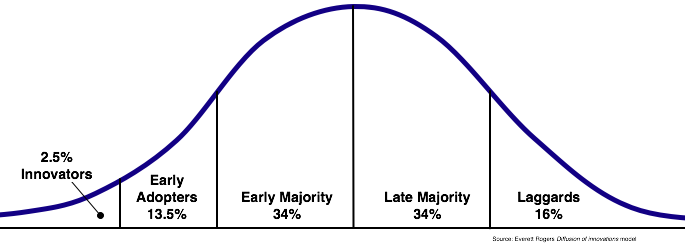|
Category: Great Advertising
March 9th, 2018

In 1999, NASA lost a 125 million dollar Mars orbiter in outer space. Seems one engineering team used English units of measurement, while another used the metric system. The mismatch prevented the correct transfer of navigational coordinates, and the aircraft missed the red planet entirely.
Before launching any new endeavor (be it marketing, or a mission to Mars), success often depends upon team alignment. The measurement mistake killed NASA’s mission, as well as the engineers’ expected A-ha Moment: a celebration of the craft’s entry into Mars’ orbit.
If you’re planning on entering new space with your marketing, drop us an email at: heythere@mortaragency.com and we’ll make sure the all-stars on your team aren’t light years apart.
December 2nd, 2017
Look what Ogilvy did with the work we did on Cisco’s new network launch: which they christened as The Network. Intuitive.
https://www.youtube.com/watch?v=CNXNWsfNlgU
February 25th, 2016

We have spent many an hour mulling over how to exploit Moore’s Chasm theory.
But many, many more hours cursing the dynamics of the early market.
In particular, we wrestle with early adopters’ infatuation with all things new and their inability to stay loyal to ideas over time.
You see, the first buyers are often visionary in character, attracted by revolutionary change, comfortable with half-baked features and totally cool with the untested, unfinished.
They’re also needy, goal obsessed, and keen to brag. Especially about being the first on the block to grab innovation by the horns and wrestle it into submission.
They will always be among the first to quit.
Visionaries like to jump onto the next big thing. And that can be a problem. The early market is a dynamic, fickle force which can be hard to tame and even harder to keep caged.
 Source: Wikipedia Here are five things about the early market most overlook:
- The early market is always in the minority. If you talk to 100 people about your new product, only 10 will say it’s awesome. 90 will tell you it sucks. Or worse, they won’t even know it’s there. 90% rejection is hardly compelling evidence that you’re onto something.
- People who sell to the early market are rarely comfortable selling to the early market. Your team, those stalwarts who have chosen to join you on the front line of change, they too are surrounded by doubters and skeptics. So is your Board. And your investors. They want guarantees. Or at least promises. They will all push you to go for the money. Now. And the money lies in the fattest part of the Bell Curve with the elusive majority. So why aren’t you selling there now? Moore urges caution and the need to establish a beachhead first. But to do that is to sit back while someone else exploits the fat found in the middle of the herd!
- The early market is way different from the late market. To find where you are on the curve, it’s important to understand the differences between the two groups. Somewhere in your product’s journey to success is a gap. It lies between the radicalized, crazy, fanatical first-customers and their more prudent, careful, and risk-averse brethren. Pragmatists don’t trust visionaries. They think visionaries are crazy. And pragmatists bore visionaries with their endless prattling about avoiding risk and loading up your product with check-box features. Yet, significant numbers of pragmatists have to be swayed by visionaries for an idea to root and blossom.
- The traffic moves in one direction: from left to right, early to late. Ideas move from new to old. They are birthed. They grow. Mature. And eventually pass into the mainstream. And after a while they wither and die. The point here is that they rarely pass from mature to death and back to sexy again. Which means it can be hard for a new idea to retrace its steps, especially when the gloss has worn off.
- Your industry is not any different. Don’t fight the theory, embrace it. We have been teaching diffusion theory since Rogers first published Diffusion of Innovations in 1962 (check this out). It’s hardly a new idea or a novel expression of market development. The principles are tried and tested. Sure you can break into a market by penetrating the middle: but it takes a lot of money. That’s why so many Super Bowl advertisers are major, established brands — Coke, Pepsi, Jeep, Bud — and why so few companies trust debuting a novel idea in a $3 million commercial. So if you are outside the mainstream, you can gain a significant advantage by embracing the lessons of market adoption theory and watching your own customers for the telling signs of quivering, flighty pioneerdom. And even find ways to cross the chasm to that big, fat majority market. But more on that in another piece.
That’s how we see it. Join the conversation. #whatifmortar
August 29th, 2013
Have y’all seen these recent ads for Sauza? Hmm. Hunky guy with muscles narrating against a kitschy backdrop. Wait, I’ve seen this before! It’s gotta be good, right?
Sauza Tequila, “The Refreshing Lifeguard” (2013) – 670,000 views
https://www.youtube.com/watch?v=BK642YwfP7E
Hey! That wasn’t the least bit entertaining. Thanks for making my minute of procrastination totally not worth it.
Sorry – we’re making a point. Ever since W+K’s Old Spice campaign broke the YouTubes with 46 million views, it seems like everyone in the hemisphere has tried to replicate its success. Of course, male ad icons are nothing new, having been a marketing staple since the days of the Marlboro Man and the Brawny lumberjack. (Btw, have you seen Brawny boy’s 21st century makeover? Eesh. Someone should let him know mustaches are in again.)
Continue reading →
February 6th, 2013
For those of you who were face-deep in the guac during the commercials, enjoy our biased topline summary. For those of you who missed the game entirely, be glad your face muscles got to relax rather than violently cringe while watching the 49ers try to defend the pass. Any pass. Eesh. The 34-minute blackout was more fun to watch than that shoulda-been-a-comeback final play. It’s ok, though, because GIANTS. And now a message from our sponsors.
The ones that made us laugh:
Oreo, “Whisper Fight”
Continue reading →
|


